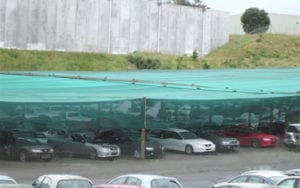What makes a Shade house Strong?
This article was written in response to queries after Hurricanes Frances and Jeanne wrecked a number of shade house in South Florida, but had virtually no effect on WeatherSolve shade house
Strong and durable shade house is a must for growers concerned about their market.
The increase in cost is small, but the financial savings after a storm are substantial.
Many rural areas accept lower standards for agricultural buildings, calling them “temporary” or “low risk” structures. They may be low risk to the general public, but are they low risk to you?
Poor construction can cost more than just the replacement value. You must also consider the loss of specialized root-stock, the loss of plants to sun if the fabric has blown away and cannot be quickly replaced, and the loss of markets that look elsewhere for their supply. Growers with poor houses also talk about the loss of sleep every time there is a moderate storm- will their shade house be there in the morning?
This does not need to be you.
So what enables a shade house to survive where others are as durable as the proverbial candle in the wind? It comes down to strength in three critical areas.
- Foundations
- Fabric connection
- Fatigue
Let us consider these three “F” words. Then after the next big storm you will be swearing by your shade house, not swearing at it.
Foundations
Wind over shade fabric sucks the fabric up in the air as well as dragging it sideways. For example a 70% shade cable house with poles on a 24ft (7.3m) x 24ft (7.3m) grid in a 120mph storm would produce over 4 tons of uplift on each pole! Considering this it is easy to see why some houses get lifted out of the ground. When the inside poles come loose, all the load goes to the outside which then overloads the perimeter anchor system. The perimeter anchors also take most of the sideways load, which increases dramatically if the outside walls are vertical. On a cable shade house, the perimeter anchors and cables (and particularly the corners) are a tiny portion of the total cost, yet when they fail, the whole structure starts failing. Good anchors are deep with large plates. As a rule of thumb, the easier it goes in, the easier it comes out!
Fabric connections
Good shade fabric is naturally strong. It may have as many as 20 yarns per inch, and each yarn will have a break strength of over 6lb (2.7kg) when the fabric is new. The trick is to connect the edge of the fabric in a way that picks up as many of the yarns as possible. Eyelet systems, for example only pick up a few yarns close to the eyelet. Other systems such as WeatherSolve’s hem system pick up virtually all the yarns. The difference may not show up immediately, but over time, as the strength of the fabric reduces because of the degrading effect of ultra-violet light, the difference becomes critical. The tension in the yarns also depends on the span of the fabric (the distance from cable to cable). Wider spans increase the fabric tension, so if your design calls for wide spans (say 12 ft or more), a high quality edge system is essential.
Fatigue
A wind storm does not produce steady wind. There are large balls of wind 20ft (6m) to 100’s of ft in diameter moving in the general wind-stream. These are the gusts which produce movement and impact loads. Loose cables and fabric snap backwards and forwards and slowly get looser. The impact loads vibrate anchors loose (especially in sand). Cables bent backwards and forwards many times eventually break.
The solution to all these problems are correctly sized components, and tautly installed fabric and cables. There are also some cable arrangements which are much more prone to failure. A common example is passing cables through poles without any clamp system to lock them in place.
Fabric is also susceptible to abrasion. This is where the fabric is rubbing on a semi-fixed object. Rough surfaces such as timber beams and poles are a big problem. So-called support cables can also create weak spots in the fabric.
So there you have the 3 F’s of a quality shade house. Small details dramatically affect strength and durability.
Consider them when your considering your new shade house. The details add little to the cost of the house, but dramatically increase the strength.
Now that’s good value for money!




